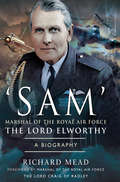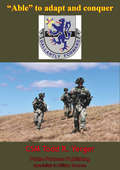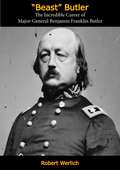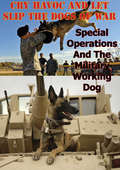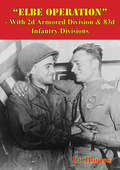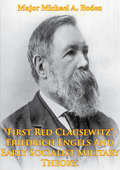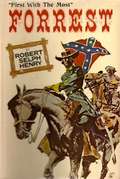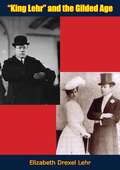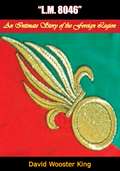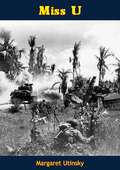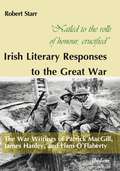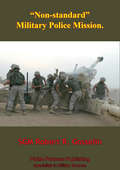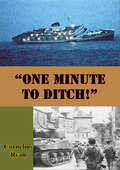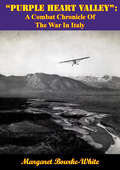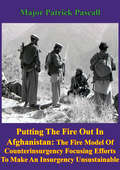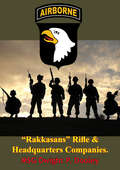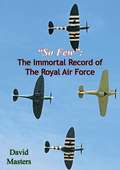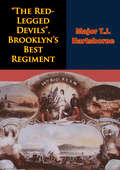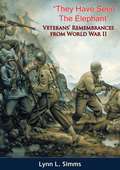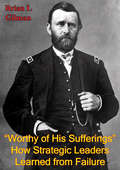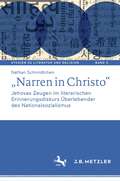- Table View
- List View
‘SAM’ Marshal of the Royal Air Force the Lord Elworthy: A Biography
by Richard MeadSam Elworthys career was remarkable by any standards. Born in New Zealand in 1911 and educated in England, he was called to the Bar. After learning to learning to fly he joined the RAAF. During the Second World War he won the DFC, DSO and AFC and, after commanding 82 Squadron, worked closely with Bomber Harris and General Eisenhower. He became an air commodore aged 33.His meteoric rise continued post-war. Switching to Fighter Command he saw service in India, Pakistan, and the UK before becoming Commandant of the RAF Staff College. By 1960 he was tri-service C-in-C Middle East and his actions prevented the invasion of Kuwait by Iraq.As Chief of Air Staff and Chief of defense Staff in the 1960s he fought the Services corner at a difficult political and economic time. He secured the long term future of the RAF, whose very existence was threatened. A hugely respected figure, he became a life peer, Knight of the Garter and Constable of Windsor Castle. He died in 1993 in his native New Zealand.This long overdue biography attempts successfully to do justice to a man of great stature, integrity and achievement.
“Able” To Adapt And Conquer (Eyewitness To Modern War #1)
by CSM Todd R. YergerDuring Operation Enduring Freedom (OEF) VII and VIII, Able Troop 3-71 Cavalry operated as the brigade rapid mounted reaction force throughout Regional Command East (RC-E) and South in Afghanistan. This paper tells of how our unit moved in-between Regional Commands to deter and destroy the enemy, set up multiple Combat Out Posts (COP), trained Afghanistan National Police (ANP), dealt with the first extension and set the stages in the North for follow on forces.
“Beast” Butler: The Incredible Career of Major-General Benjamin Franklin Butler
by Robert WerlichFirst published in 1962, this is a biography of Benjamin Franklin Butler, (1818-1893), aka “Beast” Butler, an American lawyer, politician, soldier and businessman from Massachusetts, who became best known as a political major general of the Union Army during the American Civil War, and for his leadership role in the impeachment of President Andrew Johnson. He was a colorful and often controversial figure on the national stage and in the Massachusetts political scene, where he served one term as Governor.“In the history of the United States, there has never been anyone quite like Benjamin Franklin Butler. Without a doubt one of the most incompetent Generals and corrupt politicians this nation has ever seen, Butler was accused during the Civil War, of murder, trading with the enemy, theft, maltreatment of women, blackmail, and arson. He was the only Union General that the Confederacy ordered hanged on the spot if captured.With his malefactions public knowledge, he became after the War, successively five times Republican United States Congressman, Democratic Governor of Massachusetts, and Greenback-Peoples candidate for the Presidency. He achieved these high positions by sheer bluff, taking care of his supporters, and by an oratorical ability to twist any occurrence, no matter how incredible, stupid, or shady into a vindication of himself. He was a demagogue’s demagogue.”—Robert Werlich, Foreword
“Cry Havoc And Let Slip The Dogs Of War”. Special Operations And The Military Working Dog
by Major Joseph F. WhelanThis paper examines the potential for military working dogs to support Special Operations Forces (SOF). Modern technology has not eliminated the operational prospective for the military employment of dogs. Canine olfactory superiority, advanced hearing, and ability to detect movement offer significant military employment potential. Military working dogs can be trained for scouting, patrolling, building and ship searches, countermine, counterdrug and tracking. When used properly, dogs are an inexpensive and efficient force multiplier.Qualitative research using correlational data comprises the monograph's methodology. Military working dog capabilities, limitations, and historical employment will be discussed and then compared to Special Operation Forces principal missions and collateral activities.The conclusion demonstrates that dogs have a wider role to perform in today's operational environment and that military working dogs can augment and complement SOF operations. Nearly every SOF mission can benefit from the inclusion of dogs- particularly in support of Stability and Support Operations conducted in developing countries that cannot employ or sustain complex and technologically sophisticated equipment. Military working dogs are a proven, low technology, combat and combat support capability and may have a future role in support of Special Operations Forces.
“Dear Fatherland, Rest Quietly”: A Report on the Collapse of Hitler’s “Thousand Years”
by Margaret Bourke-WhiteTHIS IS the story of the search for “Faceless Fritz”—the most difficult and frightening camera-hunt ever undertaken by ace photographer-reporter Margaret Bourke-White. “Fearless Fritz” was cable shorthand for one of several LIFE assignments that brought Miss Bourke-White and her camera to Germany some months before its fall. She was to pin down the private German citizens—to find out what kind of human being it was who, multiplied by millions, made up the Nazi terror. Was he cruel? Was he a villain? Or was he a jolly, gemutlich, beer-drinking, music-loving sentimentalist so many of us remembered, who had really been helpless in the power of a small gang of madmen?By the time Margaret Bourke-White arrived in Germany on this mission, she had seen much death and danger. She had been in Moscow during its fiercest bombings. In Italy she had come closer to the enemy lines than any American woman before her. But it was in Germany that cold horror overtook her.The Germany that Miss Bourke-White saw and recorded in this book puts to shame Dali’s most grotesque nightmares. It is a physical and spiritual chamber of horrors, a cuckoo-cloud land whose inhabitants live in a lost dream. They are the people whose faces are as usual and recognizable as neighbors’, but whose reactions do not seem to make sense.“Dear Fatherland, Rest Quietly,” which was first published in 1946, takes its title from the words of the anthem, “Die Wacht am Rhein,” to which German soldiers have marched three times in the memory of many now living. It brings new light to bear on the German people—in the hope that through a more immediate understanding of them, a fourth march may be averted…Richly illustrated throughout with 128 of her photographs, with detailed captions, forming an integral part of Margaret Bourke-White’s important report on conquered Germany.
“Elbe Operation” - With 2d Armored Division & 83d Infantry Divisions
by Lt. HoucekThe crossing of the Elbe River was to prove a mortal blow to the hopes of the Nazi Command to continuing resistance to Allied forces in the West. The 2d Armored "Hell on Wheels" Division and 83d "Thunderbolt Division were the spearheads of the Ninth US army and they were the units who were first to seize the crossing of the Elbe. However the units were halted on orders from above and their advance was to be the furthest east the Allies reached during the hostilities and mark the point at which American and Russian Forces met for the first time. This short monograph produced by the European Theater of Operation historian Lt. Houcek was based on the oral testimony collected from the men involved.
“First Red Clausewitz”: Friedrich Engels And Early Socialist Military Theory
by Major Michael A. BodenBetween the European revolutions of the mid-nineteenth century and the Franco-Prussian War in 1870, Friedrich Engels functioned as a writer, analyst, and critic concerning military affairs. His most essential commentaries were published, disseminated, and internalized by supporters of the proletarian revolution. This project concentrates on the tactical, operational, and technical aspects of Engels' military thought and the development of his concepts from his earliest writings until the Franco-Prussian War. Historians and commentators routinely ignore these aspects of military theory in examinations of Engels' work. This project will demonstrate that Engels possessed are markable level of military knowledge and a degree of insight at the operational and tactical levels of warfare and that that he should be considered not only as an important social and economic thinker, but also among the most significant contributors to the field of nineteenth-and twentieth-century military history and theory. Engels' most significant contributions exist in the manner by which he, as a key member of the socialist leadership in the nineteenth century, integrated the concept of armed insurgency into the conduct of a proletarian revolution. By drawing on the experiences of the French Revolution and the wars of Napoleon, and then the impact of mass-industrialization, Engels was the first person to specifically incorporate a force dynamic into the trajectory of a socialist revolution. Despite the fact that he was a civilian with no formal military training beyond service as a Prussian artilleryman in 1842, his contributions to the field of revolutionary military theory earn him distinction as one of the most important socialist writers of the nineteenth century.
“First With The Most” Forrest
by Robert Selph HenryNathan Bedford Forrest did not invent mobilized guerilla warfare, but he did modernize and polish it to an extent that has left few theoretical areas for improvement. Tanks and jeeps, it could even be said, do not possess the mobility relative to the main force which they attach that Forrest's dedicated band of horsemen enjoyed. Following in the footsteps of Francis Marion and Lighthorse Harry Lee, American practitioners of the devastating hit-and-run cavalry attach of the Revolutionary War, Forrest raised their effective but geographically limited campaigns to an art-form spread over the widest possible tactical theatre. He accomplished this with superior knowledge of terrain and of horses coupled and with an iron will, a complete disregard for physical exhaustion (his own and that of his men) and, this book will demonstrate, by the most admirable sort of sheer country orneriness.Forrest, a man of simple upbringing, is the perfect symbol for the odd mélange that was the Confederate Army; patrician West Pointers like Lee side by side by unregenerate racists like Forrest. These well-bred students of battles and from the classical era were not prevented by an almost unimaginable difference in class from being able to recognize the tactical genius of a farmer from the low country...That any scholar of this history of warfare would have to judge Forrest rather more harshly for his conduct after the war than this conduct during it is just another tragic aspect of the larger tragedy that generated The War Between the States. Heroes rose from unlikely places and returned, when the time for heroism had past, to their more unheroic pursuits. Whether than return negates the valor shown during the conflict is only for you to determine, after you have learned of Forrest's life in all its aspects, heroic, and less so.
“King Lehr” and the Gilded Age
by Elizabeth Drexel LehrHARRY SYMES LEHR was born in 1869 into a family that was neither wealthy nor socially prominent. His natural gift for entertaining and his penchant for hobnobbing with the very rich earned him entry to the powerful circle of the New York and Newport social elite, where Harry clowned his way to a position of prominence. One of his admirers and patrons, Mrs. Stuyvesant Fish, introduced him to a young widow, Elizabeth Wharton Drexel. Elizabeth was smitten with young Harry, his elegant dress, and outrageous behavior. They were soon married.But King Lehr had a secret—he was not what he seemed. On their wedding night he cruelly dictated the rules of their strange relationship to his new bride. For twenty-three years, Mrs. Lehr protected his secret and remained in a loveless and abusive marriage.After Harry’s death Elizabeth remarried, to the Baron Decies. Lady Decies wrote down her secret story in 1938, incorporating Harry’s most intimate diaries, and told all in this scandalous tale of power, desire, and deception.
“L.M. 8046”: An Intimate Story of the Foreign Legion
by David Wooster KingStill a student at Harvard when World War I broke out, American David Wooster King joined the 135th Regiment of the French Foreign Legion in November 1914 and fought in the 1915 Champagne offensive and at Verdun and the Somme in 1916. He transferred to the American Army near the end of the war and served in the counterespionage section at Chaumont.“This book of David King’s is not a sermon. It does not preach and it carries no moral. It says in fact: ‘Here, my good friends who made me into a beautiful hero, is what happened to me while I was gaining that title. Take it or leave it and be damned to you or have a drink with me or do whatever you please, but for Heaven’s sake don’t kiss me for I am splashed with the blood of my dead comrades and I am dirty with the grime of a million miles of road.’”—Hendrik Van LoonA colourful and engrossing account, especially for 1915-1916.
“Miss U”
by Margaret UtinskyThis is the story of the heroism of Margaret Utinsky, who, against unbelievable and fantastic odds, for three years led an underground organization in the Philippines in a relentless and telling effort to aid American prisoners of war held by the Japanese. Dauntless and determined, she pushed into the background her own personal loss, faced the twin demons of physical and mental anguish, and “stood up” to circumstances and conditions which most of us find inconceivable. In her own words, she became “accustomed to doing the impossible.” And gaunt prisoners behind walls and wires, guerrillas in the hills, the faithful in Manila—all felt the force of the courageous leadership of this small dynamo, for whom “something always happened.”
“Nailed to the rolls of honour, crucified”: The War Writings of Patrick MacGill, James Hanley, and Liam O’Flaherty
by Robert StarrThis book explores the war writings of Patrick MacGill, James Hanley, and Liam O’Flaherty, working class, Roman Catholic Irishmen, all of whom fought in the First World War as privates and who, collectively, it is argued, constitute a distinct trio of war writers. Through discussions focusing upon class, camaraderie, violence, religion, trauma, and the body, this book considers these Irish soldiers within a cultural, social, and historical context. Central to this examination is the idea that the motives for enlistment and the experience of army labor and even combat was such that military service was perceived as work rather than a duty or vocation undertaken in support of any prevailing doctrines of patriotism or sacrifice. The men’s Catholicism also shaped their aesthetic and philosophical responses to the war, even while the war conversely troubled their faith or confirmed their religious skepticism. The war writing of these men is located within both an Irish and a pan-European literary working class tradition, thereby permitting the texts to be viewed within a wider context than literature of the First World War, and from a perspective that goes beyond Ireland and Britain. These characteristics shape a perspective on the conflict very different from that of the canonical officer-writers, men such as Siegfried Sassoon, Robert Graves, or Edmund Blunden, whose work is considered alongside those of the three Irish soldier-writers.
“Non-Standard” Military Police Mission (Eyewitness To Modern War #2)
by SGM Robert R. GosselinMy field artillery unit was mobilized to perform a non-standard military police mission during Operation Iraqi Freedom II. The unit was part of the largest National Guard mobilization from our state since the Vietnam era. The challenges of deploying a field artillery unit as an ad hoc MP company were many. The challenges were overcome through the strength of our NCO Corps. As I write this paper, I am preparing for a deployment, a non-standard mission with my current unit. As I compare the two mobilizations, it is apparent that the process for mobilizing, training and preparing our soldiers has improved since the first rotation, but issues concerning the selection of units for non-standard mission still exist five years later.
“One Minute to Ditch!”
by Cornelius RyanPrize-winning True Stories of the Supreme Moment--When Men Suddenly Face DeathSome of these true stories are already famous because they have been dramatized on television. All of them take you straight to the heart of great moments of crisis.You'll know what it's like to look down at the wide Pacific and realize that your plane is going to ditch there.You'll twist the wheel of your racing car as it takes a narrow turn at Indianapolis.You'll struggle in cabin 56 of the S.S. Andrèa Doria during its five last frantic hours.In these and other stories, Cornelius Ryan, ace journalist, has caught the essence of that split-second that may be a man's last. Two of these pieces have won Benjamin Franklin Magazine awards."One Minute To Ditch!"--Thirty-one men, women and children high over the mid-Pacific in a failing plane. (Dramatized on TV.)Five Desperate Hours in Cabin 56--A story of the sinking of the S.S. Andrèa Doria told in gripping minute-by-minute detail. (Dramatized on TV.)The Major of St. Lô--A classic of the Normandy invasion, an unforgettable true story of quiet heroism. (Dramatized on TV.)These and other factual accounts are moving documents of crisis: of courage against the sudden fact of very possible death.
“Purple Heart Valley”: A Combat Chronicle Of The War In Italy
by Margaret Bourke-WhiteAn excellent, richly illustrated, account of the bloodiest phase of the Italian campaign.Here is a report--in pictures and in words--of exactly what happened to our men during the bitterest phases of the Italian campaign. This report is not based upon a hurried visit behind the lines; Margaret Bourke-White spent a full five months on the Italian front photographing, questioning, observing, and living in close association with our troops. She was not content to remain safely behind the combat area. She flew over the German lines and narrowly escaped being shot down. On the ground she came closer to the enemy lines than any woman has been before the most advanced American post around Cassino.
“Putting Out The Fire In Afghanistan”: - The Fire Model of Counterinsurgency: Focusing Efforts to Make an Insurgency Unsustainable
by Major Patrick PascallThis monograph develops an alternative approach to counterinsurgency, and explains how the current narratives in the field of counterinsurgency are not completely accurate. Counterinsurgents only need to properly understand the environment and then concentrate their efforts in that critical area of the insurgency identified as the sustainer of that insurgency. The U.S. counterinsurgency (COIN) plan does not need to address all those lines of effort not directly related to the root cause of an insurgency, as those efforts may actually fuel the insurgency due to building unrealistic expectations among the populace.This monograph also develops the analogy that the four elements necessary for a fire (fuel, oxygen, heat, chain reaction) parallel the necessary elements of an insurgency (the fuel representing unresponsive government, oxygen representing existing structures/vulnerability, heat representing political/diplomatic factors, chain reaction representing the information environment, and the population). Like a fire, if one has a proper understanding of the environment, and can clearly identify the true sustainer of the insurgency (the root problem), then one only need to remove that one element from the equation, and that insurgency will be unsustainable.Having a simple approach will not only allow the counterinsurgents to better utilize their resources-in an Economy of Force-and allow them to Mass their power on one clear Objective, it will also remind counterinsurgents of the other Principle of War that has proven to be so critical in complex environments-simplicity.
“Rakkasans” Rifle & Headquarters Companies (Eyewitness To Modern War #3)
by MSG Dwight P. DooleySenior NCO MSG Dwight P. Dooley recounts his experiences of the War in Iraq when stationed there as part of the 101st "Screaming Eagles Airborne Division between 09/20/2005 - 05/18/2006.This paper explains the different experiences and the similarities I experienced as First Sergeant in Crusher & Hatchet Company, 1-187TH Infantry Regiment. Both companies presented completely different experiences but they were equally satisfying. My rifle company was a company known for its rough around the edges attitude and for its ability to eliminate any opposing threat. My headquarters company was known for its ability to figure things out and apply a logical and methodical approach to everything. These two companies were completely different in nature, but equal in their abilities to accomplish any given task.
“So Few”: The Immortal Record of The Royal Air Force
by David MastersOriginally published in 1941, this book is author David Masters' historical account of the Royal Air Force's feats and accomplishments during the Second World War: "I count it a privilege to write with firsthand knowledge of these flying crusaders who are fighting a holy war to preserve Christendom and the lives and liberties of earth-bound mortals. They are the flower of Great Britain and the British Empire, selected in the most scientific manner for the posts of honour which they have covered with so much glory. None but the best will do, and those who achieve their desire of becoming pilots and navigators and gunners and wireless operators in the Royal Air Force are in fact the finest specimens of young manhood who walk the earth, young men whose physical fitness, nervous control, mental alertness and swift muscular reactions make them fit to command and man the giant bombers and handle the darting fighters; they are the knights of the air whose prowess and sacrifice will conjure a new and nobler order out of the ruins created by Hitler and Mussolini. No trouble has been spared to ensure the accuracy of these pages which reflect the glory of the Royal Air Force. It may be taken that they are as authentic as any pages of official history."
“The Red-Legged Devils”, Brooklyn’s Best Regiment
by Major T.J. HartshorneThe Fourteenth Regiment New York State Militia of Brooklyn, New York gathered an impressive combat record during the Civil War, yet the Professional Military Education world rarely takes notice of their deeds. They were first formed on 5 July 1847 when the New York State Legislature consolidated the individual militia companies into regiments. During the Civil War the Fourteenth Regiment fought in 29 engagements and sustained over 700 casualties. Their battles include participation in both Bull Runs, Antietam, Fredericksburg, Chancellorsville, Gettysburg, Wilderness and Spotsylvania. Though noted primarily for actions in the Civil War, the Regiment also served in the Spanish American War, World Wars I and II, and Korea, though under different unit designations. The Fourteenth Regiment's past can be a road to our future. An insight to their performance under fire can provide today's students a timeless template on how to conduct combat operations.
“They Have Seen The Elephant”: Veterans’ Remembrances from World War II
by Lynn L. SimmsThese stories happened over 40 years ago, all over the world, and they are set down here so they can remind us of other times and places where Americans fought for their country. No single soldier "won the war," rather each was trained, went where he was told and did his job when needed.War became a way of life, an opportunity for undreamed-of travel, a time in which many grew up, some received equal treatment for the first time, some enjoyed working as part of a team, some felt proud, but for all it was an experience few would have wanted to miss, but none would want to repeat.
“Worthy Of His Sufferings”: How Strategic Leaders Learned From Failure
by Brian J. GilmanHistory provides numerous examples of leaders who failed at some point in their career, yet went on to become great leaders. Their example demonstrates that experiencing failure does not necessarily equate to failed leadership-leaders can and do recover from failure to become better leaders. But how does this occur? How does a leader turn the psychological trauma of failure into an important learning experience that leads to personal growth? What leadership characteristics and actions are most important in recovering from a leadership failure? This paper examines these questions along several major themes: first, the psychological trauma of failure and the pathways to post-traumatic growth following failure; second, a study of how contemporary leaders grew from failure; and third, historical case studies on two strategic leaders who grew from the experience of failure: Ulysses S. Grant and Dwight D Eisenhower. In conclusion, the paper compares the lessons from these historical case studies to those drawn from the first two themes to identify the key leadership characteristics and actions that enable leaders to recover from failure.
„Narren in Christo“: Jehovas Zeugen im literarischen Erinnerungsdiskurs Überlebender des Nationalsozialismus (Studien zu Literatur und Religion / Studies on Literature and Religion #5)
by Nathan SchmidtchenDie vorliegende Studie ist die erste, die den Erinnerungsspuren nachgeht, die Jehovas Zeugen (Bibelforscher) in den Erzähltexten Überlebender des Nationalsozialismus hinterlassen haben. Trotz unterschiedlicher Erinnerungskulturen und -interessen seitens der Autoren ergibt sich ein einheitliches und zugleich schillerndes Bild. Häufig nur Erzählobjekte ohne eigene Stimme, bleiben sie randständig, andersartig und widersprüchlich. Jehovas Zeugen faszinieren, befremden und stören. Als Heilige, Propheten, Märtyrer, Samariter und Sündenböcke stehen sie in der Nachfolge des Sohnes Gottes. Bezüge ergeben sich auch zur Figur des christlichen Narren: nicht von dieser Welt, der Welt des nationalsozialistischen Terrors, aber zugleich in ihr und gegen sie zeugend.
